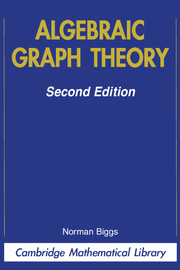Book contents
- Frontmatter
- Contents
- Preface
- 1 Introduction
- PART ONE LINEAR ALGEBRA IN GRAPH THEORY
- 2 The spectrum of a graph
- 3 Regular graphs and line graphs
- 4 Cycles and cuts
- 5 Spanning trees and associated structures
- 6 The tree-number
- 7 Deteminant expansions
- 8 Vertex-partitions and the spectrum
- PART TWO COLOURING PROBLEMS
- PART THREE SYMMETRY AND REGULARITY
- References
- Index
5 - Spanning trees and associated structures
Published online by Cambridge University Press: 05 August 2012
- Frontmatter
- Contents
- Preface
- 1 Introduction
- PART ONE LINEAR ALGEBRA IN GRAPH THEORY
- 2 The spectrum of a graph
- 3 Regular graphs and line graphs
- 4 Cycles and cuts
- 5 Spanning trees and associated structures
- 6 The tree-number
- 7 Deteminant expansions
- 8 Vertex-partitions and the spectrum
- PART TWO COLOURING PROBLEMS
- PART THREE SYMMETRY AND REGULARITY
- References
- Index
Summary
The problem of finding bases for the cycle-subspace and the cut-subspace is of great practical and theoretical importance. It was originally solved by Kirchhoff (1847) in his studies of electrical networks, and we shall give a brief exposition of that topic at the end of the chapter.
We shall restrict our attention to connected graphs, because the cyclesubspace and the cut-subspace of a disconnected graph are the direct sums of the corresponding spaces for the components. Throughout this chapter, Г will denote a connected graph with n vertices and m edges, so that r(Г) = n − 1 and s(Г) = m – n + 1. We shall also assume that Г has been given an orientation.
A spanning tree in Г is a subgraph which has n − 1 edges and contains no cycles. It follows that a spanning tree is connected. We shall use the symbol T to denote both the spanning tree itself and its edge-set. The following simple lemma is a direct consequence of the definition.
Lemma 5.1Let T be a spanning tree in a connected graph Г. Then:
(1) for each edge g of Г which is not in T there is a unique cycle in Г containing g and edges in T only.
(2) for each edge h of Г which is in T, there is a unique cut in Г containing h and edges not in T only.
Information
- Type
- Chapter
- Information
- Algebraic Graph Theory , pp. 31 - 37Publisher: Cambridge University PressPrint publication year: 1974
